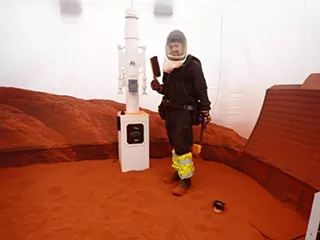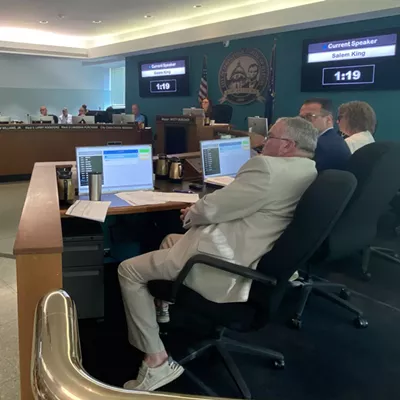Back from a 378-day NASA simulation of life on Mars, Dr. Nathan Jones says the mission at Johnson Space Center in Houston was a success, and he has no regrets about the time away from his family in Springfield.
"I missed out on a lot, but I still believe it was worth it," Jones, an emergency-room physician at Springfield Memorial Hospital and Decatur Memorial Hospital, told Illinois Times. "It was just an amazing experience, and I really believe in the work that NASA is doing there and the data that we were able to provide them."
Jones, 41, the married father of three children, ages 10, 12 and 14, was selected by NASA from thousands of applicants to be on the first four-member crew in a series of land-based missions known as the Crew Health and Performance Exploration Analog, or CHAPEA. He is a graduate of Springfield's Southern Illinois University School of Medicine and an adjunct professor of emergency medicine at SIU.
Jones, a private pilot who flew on helicopters for car-crash victims during his emergency-medicine training in Peoria, previously applied to be part of NASA's astronaut corps but was unsuccessful.
The CHAPEA missions, the second and third of which are scheduled to begin in 2025 and beyond, will help the federal agency "study how highly motivated individuals respond under the rigor of a long-enduring, ground-based simulation," according to NASA's website.
Planning for future manned trips to the moon, as well as potential stints of astronauts living on the surface of the moon, are underway. NASA is discussing but hasn't announced any timeline for a manned mission to Mars. Such a mission would require a seven- or eight-month journey each way to the fourth planet from the sun and a multiyear time commitment from crew members.
With a stipend from NASA helping to support his family during his absence, Jones, assigned the title of crew medical officer, departed Springfield in late May 2023 for about a month of training and then entered the 1,700-square-foot module, called Mars Dune Alpha, on June 26, 2023.
Jones and the rest of the crew emerged from the simulation on July 6, 2024, and went through two weeks of quarantine and debriefing sessions and other feedback before being released July 20.
Throughout the mission, he and his three fellow crew members – two women and a man – spent their days working, eating and sleeping in the enclosed area, with another area set aside for simulated treks on the lunar/Martian surface. The excursions are known as EVAs or "extravehicular activities."
CHAPEA missions will examine the challenges of living for extended periods with limited and delayed communication with NASA and crew members' families, and the effects of NASA food and exercise to combat the bone and muscle loss that can accompany reduced-gravity conditions and cramped quarters. The CHAPEA missions aren't simulating reduced gravity, however.
"We need to know that the food systems are going to be shelf-stable for the amount of time that they need to be," Jones said. "We need to know that the crews will be able to survive on them without losing critical body weight and malnutrition."
NASA isn't expected to publish studies and release data on results of the simulations until they are all complete, but Jones said he believes the first mission was a success. One reason, he said, was because none of the crew members asked to leave early because of stress or other mental or physical complications.
"Based on our experiment, you could send four people to do a real mission like this, if you chose the right people," he said.
Jones declined to describe the exact situations and challenges he and the other crew members encountered, at least until the third mission is completed, because NASA doesn't want future crew members' reactions shaped by knowledge of what's to come.
But he said, "It was a little more intense than I anticipated in the end."
One of the challenges is the 22 minutes it takes, with radio transmissions traveling at the speed of light, for messages to travel between Mars and Earth, he said.
As a result, and because of the limited bandwidth available with current technology, Jones said he was unable to communicate with his family in real time, and instead sent emails, with short videos attached.
"I can say that certainly there were things that didn't go as planned that we had a chance to react to," he said.
Interviews with Jones and other members of the crew are included in NASA's "Houston We Have a Podcast," which is online at https://bit.ly/HoustonPodcast.
On the home front, Jones said he is happy to report that he remains married to wife, Kacie Jones, a registered dietitian and full-time stay-at-home mom to their three boys.
"Thankfully, the marriage is going strong," he said.
His kids thought he was cool before, "and then I went away to NASA," he said. "At the moment, at least, I think they think they have one of the coolest dads on Earth. We'll see how long that lasts.".
Dean Olsen is a senior staff writer for Illinois Times. He can be reached at dolsen@illinoistimes.com, 217-679-7810 or x.com/DeanOlsenIT.













